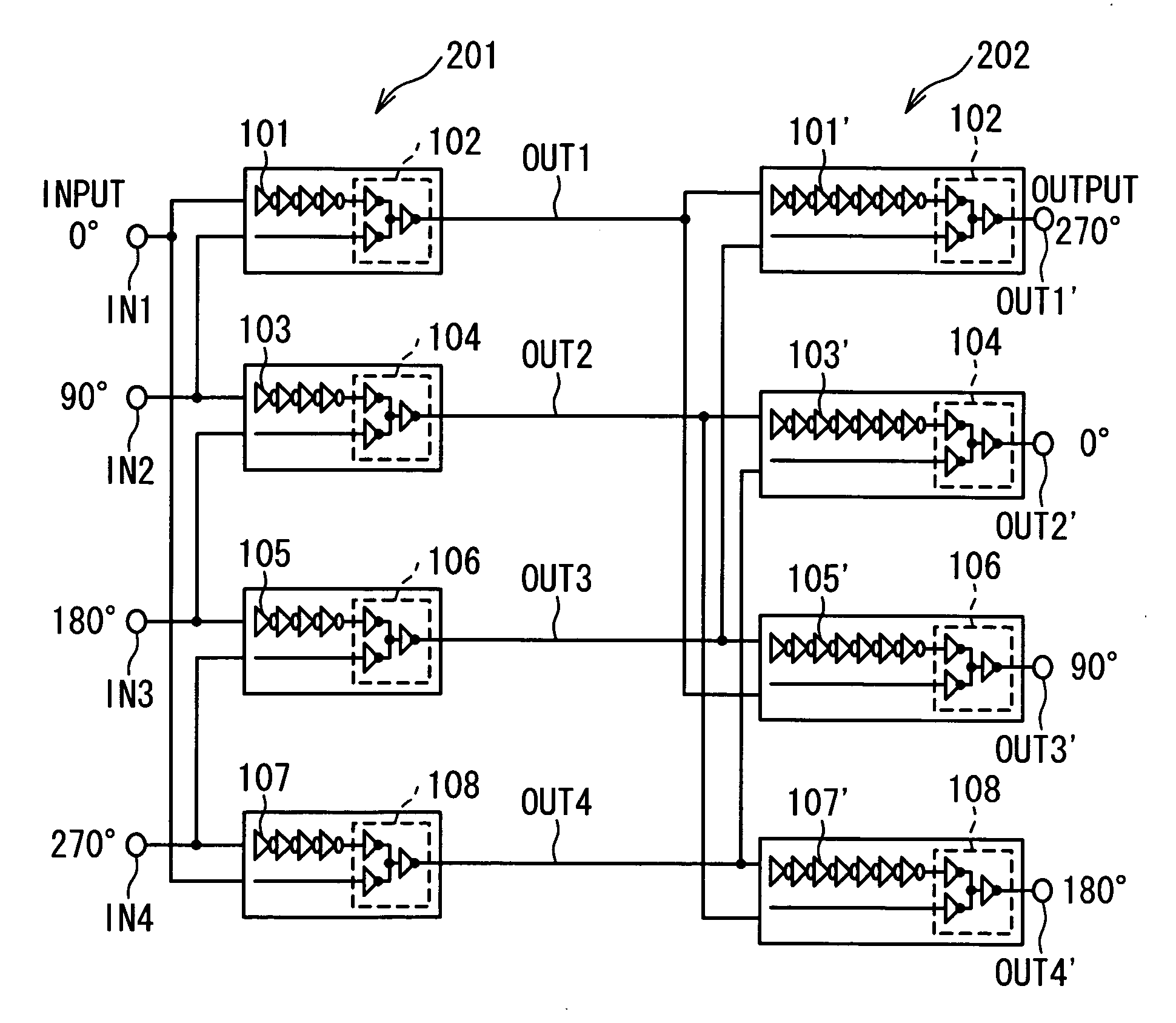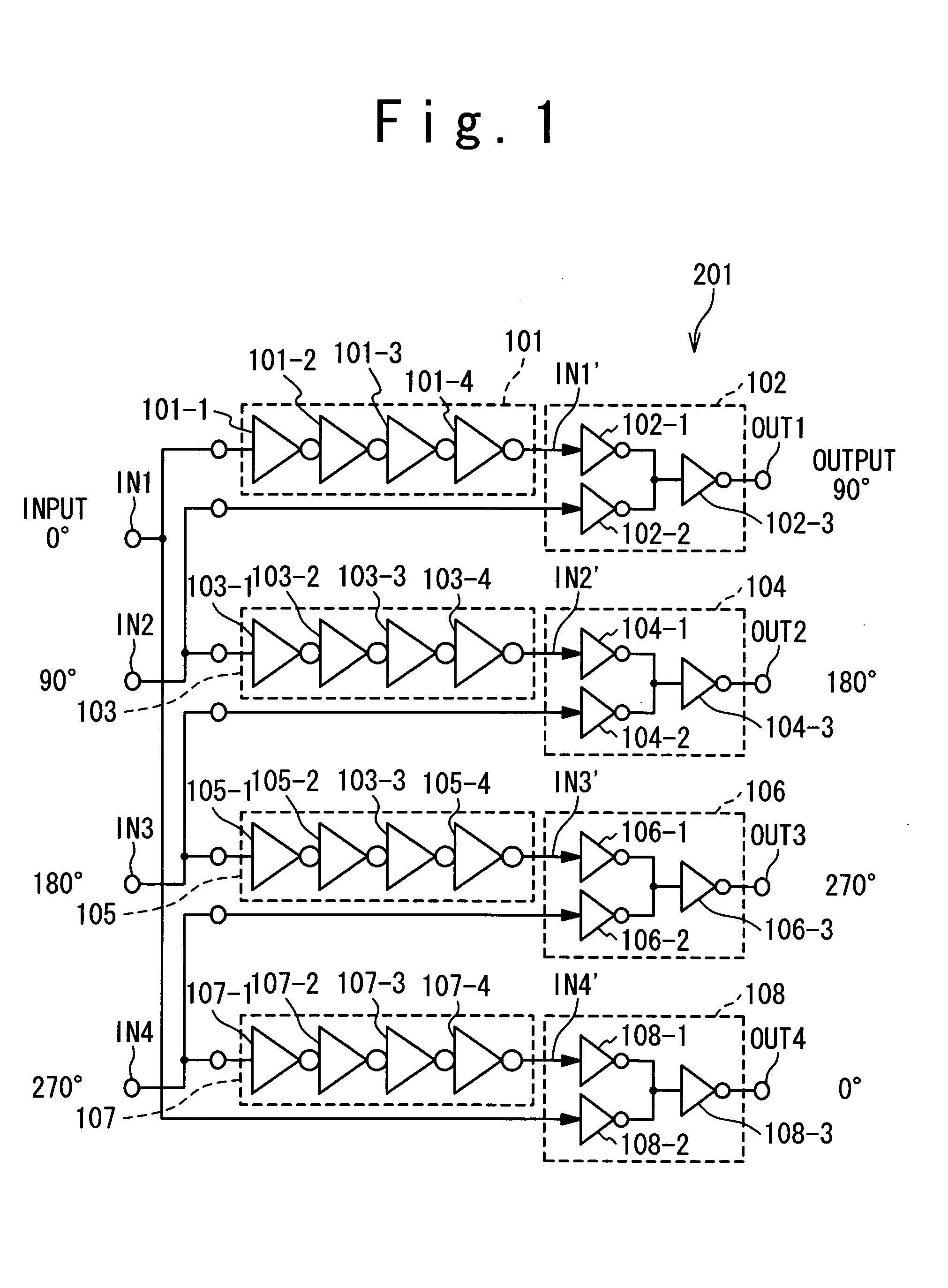Phase interpolator circuitry for reducing clock skew
- Summary
- Abstract
- Description
- Claims
- Application Information
AI Technical Summary
Benefits of technology
Problems solved by technology
Method used
Image
Examples
first embodiment
In a first embodiment, as shown in FIG. 3, a phase interpolation circuitry for multiphase clocks is composed of four delay lines 2, 4, 6, and 8, and four phase blender circuits 1, 3, 5, and 7. The delay lines 2, 4, 6, and 8 are composed of series-connected inverters. In FIG. 3, the inverters within the delay line 2 are denoted by numerals 2a through 2d, the inverters within the delay line 4 are denoted by numerals 4a through 4d, the inverters within the delay line 6 are denoted by numerals 6a through 6d, and the inverters within the delay line 8 are denoted by numerals 8a through 8d.
The delay lines 2, 4, 6, and 8 receives input clock signals IN1, IN2, IN3, and IN4, which are equally phased at constant intervals of 90° in an ideal state; the ideal phases of the input clock signals IN1, IN2, IN3, and IN4 are defined as being 0°, 90, 180°, and 270°, respectively. The delay lines 2, 4, 6, and 8 provide a delay of 90° for the input clock signals IN1, IN2, IN3, and IN4. The delayed clo...
second embodiment
In a second embodiment, as shown in FIG. 8, constant current sources, denoted by numerals 21 to 28, 41 to 48, 61 to 68, and 81 to 88, are additionally connected to the power and ground terminals of the serial-connected inverters within the delay lines 2, 4, 6, and 8. The constant current sources 21 to 28, 41 to 48, 61 to 68, and 81 to 88 effectively regulates the pull-up and pull-down currents, that is, the rise / fall times of the serial-connected inverters within the delay lines 2, 4, 6, and 8, and thereby stabilize the delay times of the delay lines 2, 4, 6, and 8 against the undesirable manufacture variance and the changes in the operation temperature and the power supply voltage. This effectively reduces the clock skews between the output clock signals OUT1 to OUT4.
In an alternative embodiment, as shown in FIG. 9, the constant current sources between the serial-connected inverters and ground, denoted by the numerals 22, 24, 26, 28, 42, 44, 46, 48, 62, 64, 66, 68, 82, 84, 86, a...
third embodiment
In a third embodiment, as shown in FIG. 11, each of the phase blender circuits 1, 3, 5, 7 additionally include a pair of constant current sources, one disposed between the power terminal of the output inverter and the power supply, and the other between the ground terminal and ground; the constant current sources connected to the power terminals of the output inverters are denoted by numerals 15, 35, 55, and 75, and the constant current sources connected to the ground terminals are denoted by numerals 16, 36, 56, and 76.
The additional constant current sources 15, 16, 35, 36, 55, 56, 75, and 76 effectively regulate the pull-up and pull-down currents, that is, the rise / fall times of the output inverters 1c, 3c, 5c, and 7c within the phase blender circuit 1, 3, 5, and 7, and thereby stabilize the delay times of the phase blender circuit 1, 3, 5, and 7 against the undesirable manufacture variance and the changes in the operation temperature and the power supply voltage. This effectiv...
PUM
 Login to View More
Login to View More Abstract
Description
Claims
Application Information
 Login to View More
Login to View More - R&D
- Intellectual Property
- Life Sciences
- Materials
- Tech Scout
- Unparalleled Data Quality
- Higher Quality Content
- 60% Fewer Hallucinations
Browse by: Latest US Patents, China's latest patents, Technical Efficacy Thesaurus, Application Domain, Technology Topic, Popular Technical Reports.
© 2025 PatSnap. All rights reserved.Legal|Privacy policy|Modern Slavery Act Transparency Statement|Sitemap|About US| Contact US: help@patsnap.com



